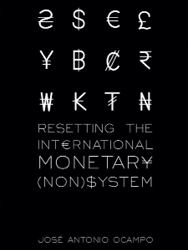Blog
An interview with José Antonio Ocampo
Why is 'Resetting the international monetary (non)system' one of the most popular economic titles at Oxford University Press?
The UNU-WIDER book ‘Resetting the International Monetary (Non)system’ by José Antonio Ocampo was recently ranked among the top ten economics books on Oxford Scholarship Online. Like all of UNU-WIDER’s publications, the book is free Open Access.
In it, Professor Ocampo lays out a proposal for fundamentally reforming the global monetary system, in order to assist developing countries, meet global goals, and improve global fairness. On 12 September 2018, I sat down with Professor Ocampo to discuss the book and the agenda it speaks to.
What follows is an abridged and paraphrased version of our conversation:
Tim Shipp: What is the international monetary system and what does it do?
José Antonio Ocampo: The international monetary system should guarantee that international liquidity is adequate, determine which currencies are reserve currencies, help countries prevent currency crises and support those that face them, and develop mechanisms to avoid macroeconomic policies adopted by some countries from negatively affecting other nations. To that end, it should guarantee that exchange rate management does not negatively affect other countries.
A good system is a system of cooperation among countries that recognizes differences between economies; particularly, the different needs of developing country economies regarding crisis prevention and the maintenance of macroeconomic stability.
Why do you call the current system a non-system?
Well, it is important to note that the term is not mine. This was a very common term used in the 1970s debates after the convertibility of dollars for gold and the fixed dollar-gold parity were unilaterally abandoned by the United States in 1971.
After that, there were attempts to design an agreed alternative system (a second Bretton Woods), taking place in the IMF Committee of 20 in 1972-74, but these failed. The result of that failure is the ad-hoc or ‘non-system’ that we have today.
What was the problem in the 1970s?
Everyone was concerned with exchange rate volatility. Before 1971, there was a broad agreement on having a global system of fixed, but adjustable, exchange rates. After 1971, the Group of 10 tried to restore that exchange rate system, but that also failed, so by 1973 currencies were mostly in a de facto float.
So, they wanted to keep the system of coordinated exchange rates, but the markets beat them?
Yes, they tried to adjust the exchange rates, and then keep them in fixed bands after 1971, but every time they pegged the currencies, the market would overrun the pegs.
Interesting, I had assumed there was a conscious decision to let currencies float.
No, no. There was a strong consensus at that time that the best system would be a system of fixed but adjustable exchange rates. Floating came about as a de facto outcome.
What is the major problem with the monetary system today?
The major issue is global imbalances and the lack of capacity to manage them.
Historically, there were Japanese, German, and Chinese surpluses, United States’ deficits, as well as those of several emerging market economies (the East Asian economies being an exception).
European surpluses are the biggest change since the North Atlantic Financial Crisis. The European Union was a major deficit group prior to the crisis, but now it is the biggest surplus economy. This is the major new imbalance in the system.
What about China’s surplus, is Europe’s a bigger issue than China’s?
Yes, it’s more important than China. The surplus of Germany alone is a bigger imbalance than China. The two biggest imbalances are the United States deficit and the German surplus.
What do you mean by surplus and deficit economies?
Countries that have a trade surplus or a trade deficit (or more broadly, balance of payments’ current account surpluses and deficits). One country’s deficit is another country’s trade surplus. But the deficit country is the one that needs external financing. If not corrected, the deficits cause external debt to balloon.
Eventually, when a deficit country can no longer get affordable financing for its deficit, it becomes prone to a crisis. In contrast, surplus economies don’t have a strong need to adjust. John Maynard Keynes was obsessed with this problem. I call it the asymmetric adjustment problem. The asymmetry between surplus and deficit economies is that the deficit country bears the burden. It is the one that, ultimately, must make the adjustment.
How would a surplus country adjust?
The method of adjustment used to be inflation. But now, surplus countries engage in austere macroeconomic policies to prevent inflation. It is a way of not adjusting.
So, the United States will have to adjust?
The United States is different, because of what the French came to call the ‘exorbitant privilege’ of having the world’s major global reserve currency. This is a different problem of the system that is known as the Triffin Dilemma, named after the Belgian Professor, Robert Triffin, who formulated it clearly in the 1960s.
There are two elements to this. First, the United States essentially has to run deficits because the US deficit is what creates the foreign exchange reserves for other countries. US debt ends up being the most important foreign exchange reserves for other countries.
Second, this implies that the most important international currency is completely subject to the national policy of the United States, not to a multilateral monetary policy.
I noticed you call it the North Atlantic Financial Crisis instead of the global financial crisis, is there a reason for that?
When a crisis takes place elsewhere, they get names – like the Latin American Debt Crisis or the Asian Financial Crisis – but when it happens in the United States, suddenly it is a Global Financial Crisis? Because it was centered in the US and Western Europe, it should be properly called the North Atlantic Financial Crisis.
I think the first person to call it that was the Indian economist Rakesh Mohan.
Okay, so what are the major problems for lower- and middle-income countries?
There are three things. The first is the asymmetric adjustment problem we just discussed. Most developing countries are deficit countries.
The second is the volatility in external financing, which is especially important for emerging economies.
And the third is what I call the fundamental inequity of the system. It is related to the demand for foreign exchange reserves. To manage the volatility in capital flows, the volatility of external financing, developing and, particularly, emerging economies need to accumulate extra foreign exchange reserves as a sort of ‘self-insurance’. In that regard, there is no alternative to US Treasury securities.
So, developing countries are forced to hold a lot of US Treasury bonds. That the poorer countries are forced to invest in the assets of the richest economy in the world is the fundamental inequity of the system.
Okay, so how do we do that?
If you look at the last crises, the North Atlantic Financial Crisis and the Eurozone Crisis, there was a big effort for reform. The G-20 formed the Financial Stability Board (FSB) and they did a lot of work on financial regulation, to strengthen banks’ capital requirements, and strongly supervise systemically important financial institutions.
But the FSB has said nothing about cross-border capital flows. It’s almost as if cross-border capital flows were not a part of finance.
Right, so they’ve ignored the most important issue for developing countries.
In my view, the most important crisis-prevention measure is the countercyclical regulation of cross-border capital flows. During financing booms, regulations have to be strengthened to avoid getting overindebted. Also, countries should accumulate foreign exchange reserves during booms, as most countries have done. And then, use these regulations during crises, again countercyclically, to facilitate capital inflows and possibly delay outflows.
Then, when a crisis occurs, you may need two additional things. First, you may need exceptional external financing. Second, if the crisis is very severe, you may want to be able to renegotiate your external debts.
On the first issue, we should really have automatic credit lines to provide balance of payments support. Historically, the IMF has pretty much done its job of providing financing, but its credit lines are not automatic. Rather, they are conditional on macroeconomic adjustment and structural reforms.
On the second issue, there is no mechanism for debt resolution. There is no dispute settlement mechanism – like there is in the WTO – at the IMF. Which is why in the book I propose a system for managing debt renegotiations.
How else do we build a better global monetary system?
There are a number of reforms that I propose in the book. These are broken down into four parts: First, the institutional reforms. Second, the global reserve system, or the way in which international liquidity is provided. Third, a system for managing the macroeconomic linkages between countries, including exchange rates, cross-border capital flows, and policy coordination. Fourth, crisis resolution and debt renegotiation, which we just discussed.
For institutional reforms, in my view, whoever is in charge should be a representative organization. That isn’t the G-20, which is basically a self-appointed organization. The G-20 represents what I call ‘elite multilateralism’. The IMF also needs to be reformed to be truly representative. It should increase the representation of emerging market and developing countries.
In relation to the global reserve system, we need a growing pool of reserves to fulfil global demand and we need a lesser role for the US dollar, to deal with the fundamental inequity of the system.
My proposal in this regard is a stronger role for Special Drawing Rights (SDRs), the global currency that the IMF issues. SDRs should be issued in much larger amounts, on a regular basis. In any case, if the IMF were to issue new SDRs in the amount equivalent to 200 to 300 billion US dollars a year, which would be adequate to fulfil the global demand for reserves, this would only increase the share of SDRs in total reserves to just over 1/10th by 2030.
My proposal is to issue SDRs as the source of financing for IMF lending, much like the way central banks create money. When a country receives SDRs and doesn’t use them, they would become IMF deposits, which would help finance its lending. This means eliminating the division in the IMF between the SDRs and general resource accounts.
Third, on international policy coordination, right now the United States holds the most important reserve currency but makes policy decisions based on national, not international concerns. It doesn’t pay any attention to spillovers. It should.
There should be coordination of foreign exchange interventions and of capital flow management. In both cases, I propose more active countercyclical management, where there is a clear role for coordination between nations. It has typically been the country that receives capital inflows that must intervene if their economy is overheating, but countries that are sending capital flows should also help to slow down outflows.
The last thing is crisis management (automatic balance of payments financing and debt-resolution mechanisms), which we already discussed.
The views expressed in this piece are those of the author(s), and do not necessarily reflect the views of the Institute or the United Nations University, nor the programme/project donors.
 Join the network
Join the network





